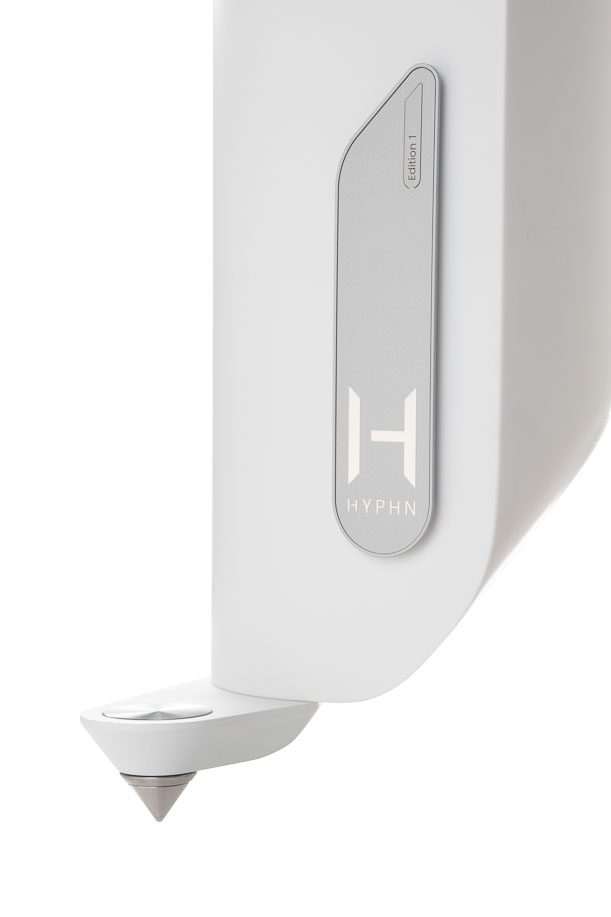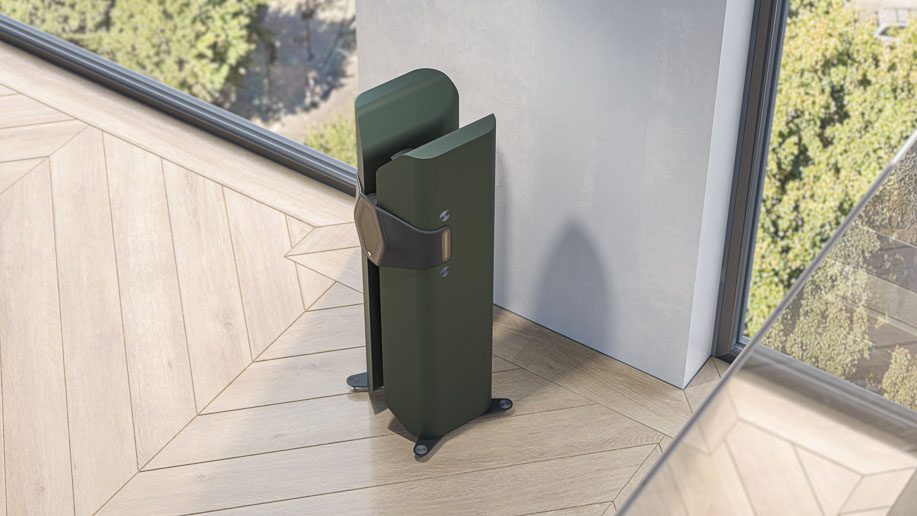
You may not yet be 50 years old, but I bet you’ve passed a significant birthday or two nevertheless. What did you do to mark the occasion? Buy yourself something nice? Throw a party? Or maybe let other people do all the buying and the throwing?
When Monitor Audio celebrated its 50th birthday in 2022, it did so by inviting its design and engineering teams to go to town on the entire idea of the passive loudspeaker. To forget the last century of orthodoxy and to reimagine the whole concept of what a passive loudspeaker might be – but to do so without ruining either the balance-sheet or the hard-won reputation the company has spent five decades establishing.
The result was ‘Concept 50’ – a design altogether more innovative and interesting than the name it was given would suggest.
Concept 50 did the rounds of the planet’s hi-fi shows, and was met with acclaim pretty much everywhere it appeared. So much so, in fact, that Monitor Audio decided to put this radical and radical-looking loudspeaker into production. And with its balance-sheet and reputation no doubt uppermost in its mind, it probably did so with that feeling of queasiness and excitement that always accompanies big, risky decisions.
Name change
‘Concept 50’ is now ‘Hyphn’ – but in almost every other respect, this looks like the same loudspeaker that was originally intended to be a design study and a conversation-piece. Beneath the skin, though, a fairly fundamental reassessment has resulted in a speaker of far greater acoustic potency than the prototype on which it’s based. And yes, it’s big and expensive – but it’s by no means as big or as expensive as any number of alternative loudspeakers from any number of alternative brands. It’s safe to say, though – and with no hyperbole – that it’s unlike any other passive loudspeaker you’ve ever encountered.
Yes, it’s a singular design – that much is apparent just by looking at it. And I don’t doubt the creative types at Monitor Audio were delighted to find the engineering approach the company wished to take allowed for such an unusual aesthetic. But Hyphn is no triumph of style over substance – this loudspeaker comes from first principles. Its appearance almost entirely follows its function.
In architecture, a ‘hyphen’ is a link connecting two separate structures. Fittingly, each Hyphn loudspeaker consists of two separate enclosures joined by the ‘M-Array’ multi-driver assembly – each enclosure has a bass reflex port at the bottom and two 103mm bass drivers facing inwards in a ‘force-cancelling’ arrangement.

These bass drivers are the third generation of Monitor Audio’s ‘Rigid Diaphragm Technology’ cone, and feature ceramic-coated aluminium magnesium for the front skin while the rear consists of two uniform layers of carbon fibre skin to reduce breakup. Optimised cone-edge treatment and rubber surrounds contribute to the light, strong structure. The RDT II boasts the lowest distortion of any cone Monitor Audio, and here they’re fixed in place by inch-thick metal rods and bolt-through fixings that run through the width of the cabinet to the rear of the driver.
Stone me!
The cabinet (or, rather, cabinets) of each Hyphn loudspeaker is/are made of an acrylic stone material – it’s seamless, thermoformable and – once it’s been milled and hand-finished – almost eerily smooth. Monitor Audio chose it for its rigidity and inertness – it’s 12mm thick, and in the area around the force-calling drivers that doubles to 24mm. This allows the multiple drivers to perform at their optimum – so the fact that the cabinet material happens to look and feel so singular is almost certainly just a happy coincidence. Each Hyphn weighs just shy of 107kg, it’s true – but once they’re in position that ceases to be an issue. As long as your flooring is equal to the task of supporting them, anyway.
(The extraordinarily static characteristics of the cabinets, coupled with the bass driver arrangement that delivers an equal and opposite reaction force, means the Hyphn is, to all intents and purposes, vibration-free no matter the pistonic activity that may be occurring.)

The ‘M-Array’ that forms the link between these two towers is an extremely compact and profoundly complex multi-driver midrange and tweeter assembly. Its painstakingly detailed design allows six RDT III 51mm midrange drivers to surround a third-generation ‘Micro Pleated Diaphragm’ transducer. The idea is to offer exemplary off-axis performance at the same time as class-leasing acoustic transparency and soundstage clarity.
The MPD II transducer has a passband in excess of 60kHz, and its square radiating area is designed to produce equal directivity in the vertical and horizontal planes. The rear volume is carefully designed to minimise ripple in the audible frequency range, and there’s a bespoke waveguide for controlled directivity and, consequently, improved soundstaging.
Six speaker special
Combined, the six midrange drivers have a surface area slightly larger than that of the RDT III midrange driver fitted to the Monitor Audio Platinum 300 3G reviewed in Issue 213. This midrange driver line-up has been created to achieve the largest amount of surface area with the smallest footprint, with the intention being the lowest possible distortion with the widest radiating area. It also benefits from considerable upper-frequency extension, and is able to cover a fair amount of the frequency range that would ordinarily be the responsibility of the tweeter – so the crossover point can be moved to 3.7kHz, where it’s less apparent. And because the MPD III transducer’s waveguide is fixed and the six midrange drivers form a flat baffle around it, there’s vanishingly little intermodulation distortion.
The crossovers themselves have come in for the same sort of obsessive overthinking as the rest of the Hyphn components. The inductors, for example, are baked in varnish – this binds the wires together and reduces vibration and mechanical resonance. Ceramic wire-wound resistors are doubled and, in some areas, quadrupled to ensure power handling up to 800 watts and to reduce power compression. The bass, midrange and high-frequency sections use individual PCBs, minimising crosstalk and magnetic fields, and are mounted on rubber isolation feet to minimise vibration.

Yes, it’s a tale of excessive this, thoroughly engineered that and overspecified the other – but the result is a loudspeaker that’s nothing like as esoteric or demanding as you might be expecting. Sensitivity is an unremarkable 86dB (2.83Vrms @1m) and nominal impedance is 4 ohms with a minimum of 3.5 ohms at 2.2kHz. Hyphn may be capable of handling 800 watts of continuous power, but Monitor Audio is adamant that 200 watts of clean power is sufficient to bring the best from this loudspeaker.
For our purposes, of course, that’s altogether too tentative. So this test is conducted using a pair of Audiolab 8300MB monoblocks with a Meridian G86 serving as a preamplifier – a Bluesound Node 2i provides the necessary streaming smarts. Monitor Audio is at pains to point out that equipment to partner a pair of Hyphn could easily be a little less, or considerably more, expensive than this without any problem – but the company is confident, and more than happy to use what is relatively modest amplification to drive these über-flagship speakers.
Content is all streamed, in file sizes that range from 320kbps to 24bit/192kHz and (the late and partially lamented) MQA. Music ranges from The Daily Growl by Lambchop and When I Was Older by Billie Eilish to Gershwin’s Rhapsody in Blue by The New York Philharmonic under Leonard Bernstein and Theme from Ernest Borgnine by Squarepusher – and quite a few points in between.
And while it’s safe to say the Monitor Audio Hyphn are at their best when streaming a fat and information-rich high-resolution file of an expensive and painstaking recording, they’re in no way snobby. If they’re given a compressed file of a cheap and/or radio-friendly recording, they’ll find the virtue in it. Their attitude is one of enthusiasm and they’re not overtly judgemental.
Low-frequency extension and presence is considerable, and the weightily powerful bass the Hyphn produces is loaded with detail both broad and fine. The rapidity of which they’re capable is profoundly impressive – the sort of nosebleed-inducing low end of the Squarepusher tune, for example, might seem designed to befuddle a loudspeaker, but the Monitor Audio simply show it who’s boss. The precision of the low-frequency attack is remarkable – bass is straight-edged in its attack, while decay is weighted precisely. As a consequence, there’s absolute confidence and positivity to the way these speakers express rhythms – no matter how hectic or how languid they might be.
Assertive and informative
The top of the frequency range is equally assertive, equally informative and subject to a similar sort of control – which is all the more impressive when you remember just how outnumbered and outgunned that MPD III transducer is. Treble attacks crisply, is tonally convincing and has the sort of attention to detail that makes the specific thickness of, say, a ride cymbal completely apparent.
The crossover between low-end and midrange, and from midrange to top end, is so smooth as to be indiscernible. And in the midrange, the Hyphn communicate to an almost indecent degree – they are as eloquent and revealing as it gets when given a vocalist to deal with, and what they don’t identify and reveal about timbre, technique and straight-up attitude in a voice isn’t worth knowing. They manage to make a close-mic’d vocal line sound intimate and wide-open at the same time, and have the sort of articulacy that makes every listen an authentic event. The harmonic variations in a singer’s voice that occur either side of the fundamental are given due prominence – but none of this insight or analysis is at the expense of engagement or entertainment.
Dynamic headroom is considerable – which won’t come as much of a shock. The Hyphn retain every scrap of information when listening to small-scale recordings at modest volume levels, and maintain their composure when a tune gets raucous or multi-faceted – even at significant volume (and let there be no doubt, the Hyphn are capable of significant, almost oppressive, volume).

Perhaps most gratifying of all, though, their powers of resolution or their ability to motor through the most testing rhythms or tempos without alarms, is the way the Hyphn organise and present a soundstage. But despite the generous size of stage the Monitor Audio can describe, it’s sharply focused and entirely convincing. The Hyphn pay due attention to the spaces and the silences on the stage, keep every element of a recording secure in its own little pocket or area, generating a remarkable impression of distance in both the left/right and front/back planes.
The Singularity
That separation is such that any individual strand of a recording is easy to isolate, the Monitor Audio integrate every aspect of recording in the most natural and confident way. Music, even cut’n’paste collages or those recordings that only ever existed in their creator’s laptop, is presented as a unified and lucid whole. A singularity, a performance.
It follows that the Monitor Audio Hyphn are among the most impressive loudspeakers around, at any price. Obviously they’re impressive in concept and in the uncompromised manner in which they’ve been executed, and obviously they’re impressive in their appearance. But there’s an almost instinctive correctness, a sort of casual-yet-unerring sensation of faithfulness, to the way they sound that makes the greatest impression.
There’s nothing new under the sun, of course, and in the final analysis the Monitor Audio Hyphn is simply a pair of passive loudspeakers with a great many drivers and a giddy price-tag. But as an indication of both where a company has been these last five decades and where it might go in the next five, Hyphn stands alone.
Technical specifications
- Type: 3-way, eleven-driver, floorstanding speaker with bass reflex bass alignment
- Driver complement: 1× MPD III micro-pleated diaphragm tweeter; 6 × 51mm RDT III rigid diaphragm technology midrange driver; 4 × 103mm RDT III rigid diaphragm technology bass driver
- Crossover frequencies: 350Hz; 3.7kHz
- Frequency response: 18Hz–60kHz
- Impedance: 4Ohms
- Sensitivity: 86dB/W/m
- Dimensions (H×W×D): 1392 × 502 × 520 (including spikes)
- Weight: 107kg/each
- Finishes: Matte black; matte Heritage green; pure satin white
- Price: £70,000/pair
Manufacturer
Monitor Audio Ltd
+44 (0)1268 740580
By Simon Lucas
More articles from this authorRead Next From Review
See all
PrimaLuna EVO 100 phono preamplifier
- Apr 22, 2024

Reiki Audio SuperSwitch Master Pro + Servant Pro
- Mar 27, 2024

Melco Audio N1-S38 music server
- Mar 27, 2024











